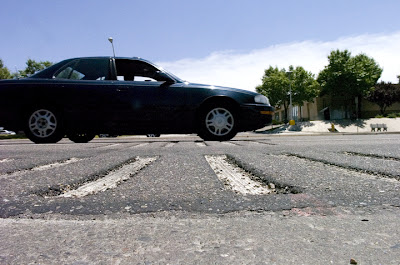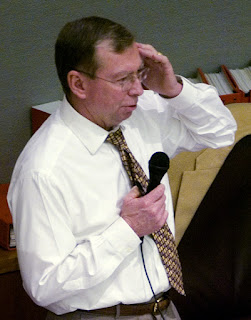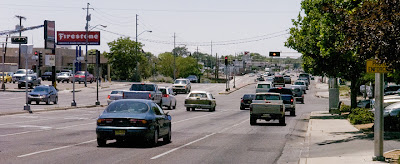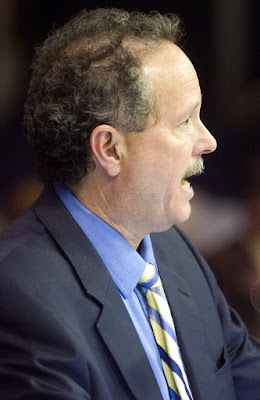 When I got back to town, I encountered the new rumble strips at intersections with automated enforcement devices, otherwise known as red light cameras.
When I got back to town, I encountered the new rumble strips at intersections with automated enforcement devices, otherwise known as red light cameras. Brrrrp, and it was all over.
So I pulled over to take a closer look.
 Gov. Bill Richardson signed a bill sponsored by Sen. William H. Payne R- Bernalillo County, left, requiring a form of notification to approaching drivers just before red light and speed camera controlled intersections. Either flashing lights or rumble strips were required. Neither Mayor Martin Chávez nor Chief of Police Ray Schultz approved of the warnings.
Gov. Bill Richardson signed a bill sponsored by Sen. William H. Payne R- Bernalillo County, left, requiring a form of notification to approaching drivers just before red light and speed camera controlled intersections. Either flashing lights or rumble strips were required. Neither Mayor Martin Chávez nor Chief of Police Ray Schultz approved of the warnings. Rumble strips mandated by state legislation that goes into effect July 1 were chosen by the city. They seem to have been placed at the proper distance. If a vehicle is approaching the intersection, at the posted speed limit and a green light changes to yellow before the rumble strips are encountered, then the vehicle cannot legally make the intersection before the light will turn red.
 It’s my belief that the rumble strips work better than I had initially imagined. One reason, they take away the need for a driver to judge the distance to the intersection once the light turns yellow.
It’s my belief that the rumble strips work better than I had initially imagined. One reason, they take away the need for a driver to judge the distance to the intersection once the light turns yellow.If you recall, I suggested that lengthening the yellow light time by a second would help.
http://mgbralley-whatswrongwiththispicture.blogspot.com/2006/12/got-couple-of-seconds.html
KOAT TV reported on April 3, 2007, that Mayor Martin Chávez announced that the yellow light time at 19 camera-controlled intersections would be extended by a half second.
http://www.koat.com/news/11515049/detail.html
There seems to be some debates about how long the yellow lights stay on.
 Apparently, on the 770 KOB AM's Jim Villanucci Show, Director of Municipal Development John Castillo, above, contended that the yellow lights had always been set at four seconds and they had not been changed.
Apparently, on the 770 KOB AM's Jim Villanucci Show, Director of Municipal Development John Castillo, above, contended that the yellow lights had always been set at four seconds and they had not been changed. So what’s wrong with this picture?
 Besides the warning sign being partially blocked, if Chávez really believes that the reason for using cameras is safety, why not do everything possible to make every intersection in town as safe as those with cameras?
Besides the warning sign being partially blocked, if Chávez really believes that the reason for using cameras is safety, why not do everything possible to make every intersection in town as safe as those with cameras?There are only 20 intersections that have cameras, but there are more than 520 intersections controlled by lighted traffic signals, according to city traffic engineers.
At those 20 intersections that have cameras, only half the traffic is monitored.
I’m not suggesting there be more cameras, but I have no problem with contributing to additional safety by having more direct informational rumble strips.
By some accounts, the Safe Traffic Operations Program or STOP ordinance and its cameras has generated more than $9 million. Chávez has always said that after costs, profits go to continuing the program. With as much money as is available, placing rumble strips at all signaled intersections could do nothing but increase safety.
 There is a secondary issue; former City Councillor and now County Commissioner Michael Brasher, left, has asked the State’s Public Regulations Commission to determine if Chávez’ claim of significantly reduced accidents was grounds for reducing insurance rates.
There is a secondary issue; former City Councillor and now County Commissioner Michael Brasher, left, has asked the State’s Public Regulations Commission to determine if Chávez’ claim of significantly reduced accidents was grounds for reducing insurance rates. It’s a fair question for Brasher to ask, however, I doubt that, even if the number of accidents at the red light camera intersections is down, and there is great question about the confidence in those statistics, the other 500 plus intersection’s numbers will not radically change the figures enough to affect insurance rates.
There have been a couple of concerns raised about rumble strips and possible problems they might cause in alignment and to motorcycles. The answer to both is that strips should pose no problems. As noted before, no self-respecting motorcyclist would admit to not being able to negotiate the grooves. The city, however, left gaps of undisturbed pavement in the middle of each lane so two wheeled vehicles might avoid them completely.
Motorcyclists tend to have a different philosophy on the road than do other drivers. Seasoned motorcyclists recognize that other drivers don’t see them and that they are at greater risk of serious injury or death should they be involved in an accident; they also are very hesitant to run red lights, though they might be prone to push the speed limits.
No comments:
Post a Comment